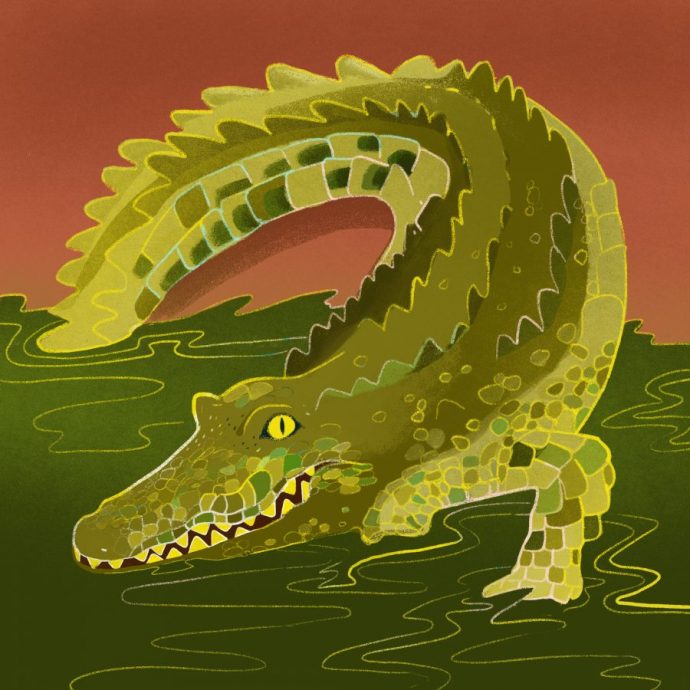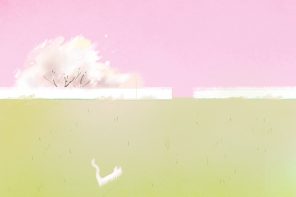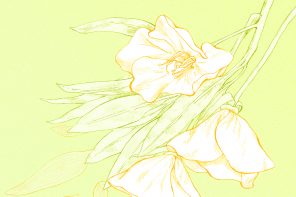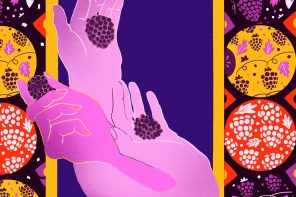Around the time land artists began accessorizing wild reptiles in earnest, the University hired an up-and-comer to create a new permanent installation. After arriving on campus, the artist decided to make her imprint on a nine-foot gator who lived in the university pond. Under sedation, she gold-plated his teeth. Veterinary students assisted, their faces anxious beneath their paper masks.
Alligators had moved north as the changing climate rendered their Southern habitats arid, and where there was one there may be more. Soon a second and third gator appeared. They dug egg-holes in the muck and caught strands of algae like floss in their jaws. Many yellow sets of eyes stared unblinking from the surface of the university pond. Their hatchlings swam in unsteady circles, grew bigger, and snapped their snouts at those humans and dogs who dared pass on the road near the retaining wall. Quietly, the gators multiplied.
Tom the Gator-Fiend, professor emeritus of medieval studies, was the first person to notice how the gators threatened to break free in search of sustenance. Over weeks of daily bird-watching, he noticed a sharp decline in the numbers of brown thrashers and tufted titmice. When he peered over the pond wall with his binoculars, he saw feathers and wrack pasted to the gators’ jowls. Though Tom told colleagues about the gators, no one at the University gave their presence much notice until a few day-drinking frat boys sacrificed fingers in a game of chicken. Tom saw the missing digits as no great loss, as he considered the continuation of the ancient battle between dinosaurs and apes to be a noble thing. The University board of trustees, however, flailed in panic. Once they realized the threat the gators posed to the recruitment of out-of-state students, they pressed for the gators’ extermination before fall term began. Dangling funding for ancient weapons research as a promise, the trustees tasked the medievalists with a pitched land battle. Most, though not all, of the medievalists itched for some of the bloodshed they studied, so they drew up a plan for constructing fortifications in the mud of the shore.
The medievalists who dissented to the plan simply avoided the University campus and set email autoreplies which referenced conference presentations or extended bouts of food poisoning. Tom, however, took the plan as a personal affront to the sanctity of the ancient battle between the species, which he saw as being fought bare-handed as a matter of honor. He also hated the trustees, in part because none of them spoke Old Norse.
Instead of staying home, Tom sat on the bridge above the laboring medievalists and jeered. Cackling, he chugged the buttermilk which he fermented from the daily excretions of his pet yak. His tongue shot out to gather strands of mucosal fluid from among the bush of his yellow-white beard. Every so often, he dug through his bag of entrails to toss a fetid chunk to a hungry gator. The medievalists glared at him with mud-streaked faces as they worked on the fortifications. A few wore many-pocketed vests purchased for their departmental butterfly-catching expedition in Costa Rica, to which Tom had not been invited.
—Tom, do you want to come down from there and help us? one of them said. She tilted back her mesh hat and shaded her eyes with her hand.
—Bring your shovel tomorrow, bigshot! said another.
As the medievalists consulted on the placement of the caltrops, their heads bowed in a circle, Tom watched a gator pick up her front legs, short arms dangling in the air, and sprint full speed after a Canada goose.
—Did you see—? Tom said, but the others ignored him.
A few weeks later, Tom sat on the stone bridge above the pond at sunset, his horn of spiked buttermilk at his side. Golden hour usually found him at the University club with colleagues from History and Classics, midway through a bottle of Malbec and a dozen oysters imported from the coast. Of late, relations with all of his colleagues had cooled. A side effect of his antagonism toward the other medievalists, he supposed.
Two gators laid side by side on the shore of the pond, their bellies sunk into divots. One used a paw to scratch at a dried patch in the dirt. At first, Tom assumed the movements and resulting pattern were made at random, but the longer he watched, the symbols appeared to him to be an early attempt at language. Zooming in, he took grainy photographs on his phone, which he sent out on a dead languages listserv.
Subject: Symbols
Message: Runic, maybe early Viking. Tom, are you quite alright?
-Edgar
Subject: Amuséments
Message: Dear Dr. Gator-Fiend, thank you for the hearty chortle. Much appreciated!
Yours in hee-haw, Dr. Brimer.
Subject: Call?
Message: Tom—This is a startling discovery, if so. Would you be able to jump on a call with some of my graduate students next week to discuss?
Regards, buddy!
Between lectures, the medievalists checked on the headway made by their graduate students with the caltrops and ditches. Thus far, no gators were imperiled or even annoyed. As they saw little progress with the anachronistic weapons of the medievalists, the trustees decided to employ a group of gator wrestlers displaced from the South. Their labor was cheap because the wrestlers were desperate for work. They lived on land near the University, tinned like fish in closely-set FEMA trailers and provided weekly boxes of cubed cheese, canned meat, and viscous sacks of fruit suspended in syrup. Before a week was out, the wrestlers captured and subdued more than two dozen gators.
Tom spent hours on the stone bridge with a drawing pad where he recorded the gators’ scratch marks. Across campus, a classroom of silent graduate students waited for him. He swigged buttermilk and took notes. The shapes appeared to be a symbolic language based on ideograms. As research, he watched Warner Herzog’s documentary on the Chauvet Cave. On the walls of the cave, ancient beasts roamed a wide and forgotten prairie. Smeared pigment depicted hairy humans launching themselves on four-legged reptiles not unlike the gators themselves.
One symbol appeared in the gator’s scratch marks over and over, three lines across with a single deep impression above the lines.

Tom wondered what the lines might mean. He considered the possibility that they were meant to mark the levels of the pond, because the stone bridge had three white stripes around one of its support pillars. Or, alternatively, a representation of some sort of seasonal change—the sun moving in relation to the horizon. The following day, Tom brought a marker and drew the gators the same symbol in return. They stared at him, unmoving, and the lines of their closed jaws appeared to him as self-satisfied smirks.
As the medievalists rested off campus, the wrestlers caught and removed the gators one by one. Like all survivors, the wrestlers sniffed out what might come next. They realized their leverage lay in their special skillset, and that once the gator removal process was finished, they would once again be out of work. United, they approached the trustees about a permanent contract to ensure the pond remained gator-free in perpetuity. The trustees chortled at them and had them thrown out of the campus hotel where they held their quarterly gatherings.
Unamused, the wrestlers went on strike. Together with students and some faculty, they paced the section of road nearest the pond, holding placards and shouting. In solidarity, the adjuncts’ union and the instructors’ union joined them on the line, and a local leftist pizza co-op donated daily pies for their sustenance. The noise of their voices disturbed Tom’s close observation of the gators’ actions.
With their hierarchy disturbed and their habitat under stress, the gators fought each other, and blood sprayed over the mud. Their bellows sounded deep into the bass range, so deep that the water on their backs beaded up and off them, so deep that they hurt the cavern of Tom’s chest and he decided to spend a few days at rest. He gathered his materials and wandered home, where his husband was working on an experimental nightshade arbor. The eggplant-pepper hybrids drooped over the wire fencing. When his husband greeted Tom, his mouth tasted of the vegetal inside of a pepper.
As Tom dozed in his seagreen armchair, comfort read splayed open on his chest (this week it was Seamus Heaney’s translation of Beowulf), he experienced a eureka moment. The deep divot markings in gator grammar, which Tom had assumed were related to natural movement, surely referred instead to the object of the sentence. They always appeared at the end of a series. Verb, object.
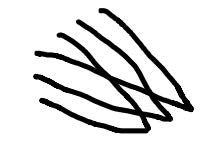
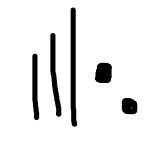
He wondered whether the divots corresponded to a category of gator—young or old, large or small—or perhaps more like an individual stamp. A name. There was one gator Tom nicknamed Jeppy, after an old lover. Jeppy ended each sentence with the same ideogram. Five scratches ended in a point at the center, with a lift at the end of the mark-making to press a single digit deep and round into the mud.
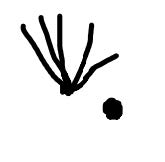
Blinking into the sun, Tom felt a surge of electric energy rush into his limbs. He sat at his desk and flipped through the drawing pad. Other gators used a repeated ideogram at the end of their utterances, though there was the outlier who used their tail to whip a shallow curve into the sandy shore, which they followed with a thumb divot.
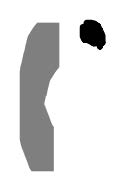
Another gator pressed the heel of their paw into the softness and let their three rightmost fingers sink.
One with extra dexterity managed to claw both paws at right angles to one another.
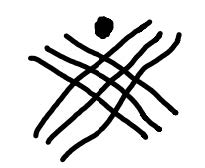
As he looked through the drawings, Tom panicked. Here were their names. Each of the gators had a name! If the trustees managed to eradicate the gators in the pond, their language, too, might be lost. He ran out to the garden to explain his findings to his husband, a retired archaeobotanist, and together they tried to make sense of the remaining drawings.
To: ALLFACULTY_L@WAINDELLUNIVERSITY.EDU
Subject: Policy Q
Message: Colleagues, a group of graduate assistants got up to some antics this weekend, as we know they are wont to do in the summer. As you can see in the attached video, they removed the live art alligator from the campus pond and “partied” with him. (In this case, their use of the term referred to serving the gator a quantity of cheap Russian vodka and the charred carcass of one of my beloved heirloom chickens. Rest in Peace, sweet Otelia). Please excuse the foul language in the audio track—I am told this song is popular this summer. What is the established procedure here for discipline?
Regards, EJJ, Dept. of Mathematics
Untended by the trustees, the medievalists, the wrestlers, and Tom, the gators found a weak point in the stone wall and dug under it. In the raw yellow of dawn, the gators spread their territories over the rest of campus. By then, the only ones left were the smartest and most dangerous. They warmed their bellies on the granite bases of monuments. Their long tails flattened the grass of manicured lawns, the beds of red and white geraniums, the hiding-places of the vanished quadrangle squirrels.
To: ALLFACULTY_L@WAINDELLUNIVERSITY.EDU
Subject: ALERT: AVOID CAMPUS.
Message: From the desk of Chief of Police Thackerthwaite— Please avoid campus for the time being. Wildlife specialists are en route to engage an ongoing safety and security issue. Advise caution to those currently present on campus. Take every safety precaution needed. And, this summer, remember to wear your helmet!
A Little Care Makes Accidents Rare.
Instead of senseless death, Tom hoped to lead the charge to herd the gators back to the pond and thereby have a caged group to study. He thought about what he and Jeppy might have to say to one another. Tom called the wrestlers and asked them to construct a fence. They agreed. The most experienced wrestler advocated for a funnel to help herd the gators in.
When Tom considered how he would surely have perished in a painful, undignified manner prior to the Permian Extinction, he prepared to arm his department against the reptilian menace. The medievalists watched in horror through inner office windows as the gators, now entirely bipedal, left claw marks on rare Classical artifacts displayed in the atrium of the humanities building. The faculty listservs buzzed with gator videos which depicted the consumption of an entire exhibit of taxidermied birds in the natural history museum and a display of 18th-century costumes in the Fiber Science wing. The ROTC faculty, who doubled as intramural kickball coaches, filmed their chalkboard strategy sessions in a barricaded gym that Tom knew to smell of armpits and heterosexual despair.
Summer came to an end and the trustees prepared for the influx of out-of-state students who would bring with them, regrettably, parents not keen on semi-aquatic sets of teeth. The trustee finance committee came to the reluctant conclusion that hiring the wrestlers back made financial sense, and so they capitulated to the wrestlers’ demands by hiring them back at double their pre-strike rate on a permanent eradication contract. Joyous shouts and hoots went up around the pond wall. The wrestlers slapped one another on their backs and shoulders.
The morning the wrestlers were scheduled to continue their intensified schedule of eradication, Tom went to the pond early, hours before the birds woke up, when his husband was still fast asleep. He lingered a moment to smell their bedroom, its shut-in morning smell his favorite: their shared musk, his husband’s night cream, the familiar sleep-farts.
When he arrived at the pond, only Jeppy was left wading in the muck. Tom painted his palm with black watercolors, pressed an imprint to the page of his drawing pad, and showed it to Jeppy.
Jeppy pressed his paw into the dirt and stared at it, then at Tom.
Tom felt a shock of recognition run its course through his body. There was so little time and the sun was rising. He drew a smiley face, eyes and mouth, and showed it to Jeppy. No response. He drew a fish. Nothing. Jeppy stared at him without blinking.
When the wrestlers arrived, they chased Tom back to the humanities building. When he passed the gators scattered around campus, they grunted and roared. A few gators had wandered into the building itself, and were lurking in the dark corners of the atrium. His fellow medievalists put aside their irritation with his antagonistic behavior and invited him to gather in the faculty conference room. They sat in chairs of upholstered plastic around the heavy wooden table, and most took the same seat they did during faculty meetings.
—Thank you for coming, Tom, said one of his colleagues. That’s why we’re here.
Tom unstrapped his horn of fermented buttermilk and handed it around the circle. Almost everyone took eager gulps, though afterward they coughed and sputtered.
—Restore the balance among all life! Tom said. Let us prevent the deaths of these noble creatures by rounding them up instead of letting them be shot. Though we are enemies, we can assist them in their time of need.
—Hoorah! said the medievalists.
They passed the horn.
—Let us drink to humanity, said the first medievalist.
—And to camaraderie, said the second.
—And to victory, said a third.
As they drank, Tom gathered the cache of weapons from his office and brought them to the meeting. They clattered from his arms onto the surface of the table. There were the swords and axes, his wooden lances, a few dented suits of chainmail and one of armor. One of the instructors brought a duffel bag full of maces, which she distributed with a sheepish grin. Others contributed shields, spears, cannonballs on chains, stacks of bridles.
Armed and drunk enough to face their fear, together they ventured into the atrium. Experimentally, a new hire wearing chain mail poked a gator with her lance and recoiled when the tip broke against the scales. The gator eyeballed her but didn’t move.
With startling grace, Tom mounted a gator and slipped a bridle on over her snout.
—Giddy up! he said. The gator ignored him. Tom crouched on her back as she ambled away from the others, out through the doors of the humanities building. Attempting to steer, he managed to tug the gator in the direction of the pond. She whipped her tail around to unseat him, though he held steady, balanced on her scales.
The others bridled the gators they could and fended off those who could not. Graduate students, being punished for the death of heirloom chicken Odelia, jogged behind the medievalists and held sharpened axes at the ready. Some of the grad students still looked hungover, their faces smeary. A corner gator bit each of Tom’s wooden swords in half.
—For our University! For all humanity! said a medievalist.
The graduate students rolled their eyes. The gators lumbered out, following the bridled ones. Tom led them back to the pond, and most followed through the new funnel gate. Once his first gator made a beeline toward the water, he jumped off and sprinted back to the atrium to catch another. On his way, he saluted the other medievalists.
The medievalists lanced and baited and wrestled until the building was empty of reptilian wildlife. A few upset sparrows chirped from the steel rafters which held up the glass dome of the atrium. Tom closed the funnel gate to the pond, where the wrestlers were distributing the gators and choosing which ones to remove, and he and the rest of the medievalists called it a night. Sweaty and muddy, their linen shirts torn, they filled glass steins with foamy beer at the deep-dish pizza joint and toasted to their shared success.
Six months later, Tom the Gator-Fiend published the last paper of his academic career, “Towards a Gator Grammar”. It considered the rudiments of written language for the gators and pointed toward a future for the study of the University Pond dialect. Subsequently, he went emeritus and spent most of his days sitting by the pond, drinking his buttermilk and trying to communicate with the remaining gators. On campus tours, the guides introduced him as a semi-permanent fixture. Tom’s husband was glad that Tom had a hobby outside the house.
The gator wrestlers were finally able to pull Jeppy from within the reaches of a rock cave at the side of the pond. A livestream of one of the wrestlers’ helmet-mounted cameras showed the beam of their searching lights illuminate Jeppy’s glittering mouth. The University constructed a tall, electrified fence around the pond, and when the wind was right it carried the odor of fried squirrel to the new first-year dormitories. Spring term began, the year anew. As the icy mud of the pond thawed, an egg shifted. The egg-tooth within tapped a small hole, which widened. A tiny yellow eye peered out.
Emrys Donaldson is an Assistant Professor of English at Jacksonville State University in Alabama. Their work has recently appeared in TriQuarterly, Redivider, Passages North, and The Rupture, among other venues. Read more at emrysdonaldson.com.

